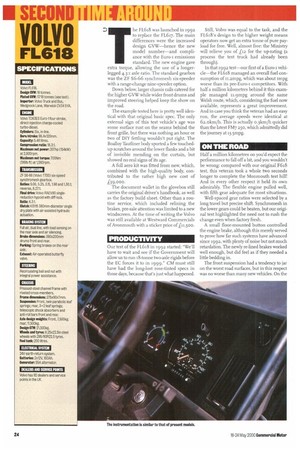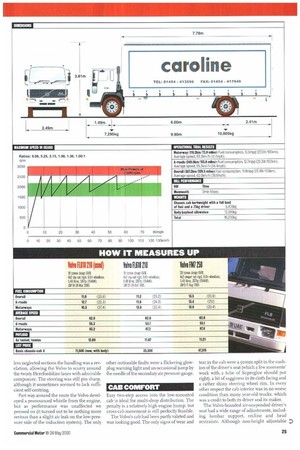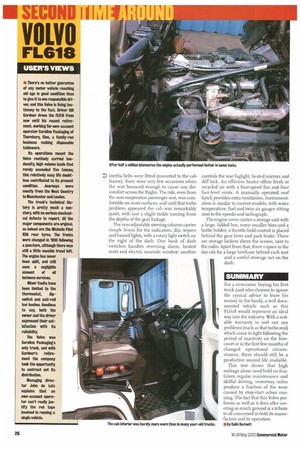he F L618 was launched in 1992 to replace the
Page 26

Page 27

Page 28

If you've noticed an error in this article please click here to report it so we can fix it.
FL617. The main differences were the increased design GVW—hence the new model number—and compliance with the Euro-r emissions standard. The new engine gave extra torque, allowing the use of a longerlegged 4.3:1 axle ratio. The standard gearbox was the ZF S6-66 synchromesh six-speeder with a range-change nine-speeder option.
Down below, larger chassis rails catered for the higher GVW while wider front drums and improved steering helped keep the show on the road.
The example tested here is pretty well identical with that original basic spec. The only external sign of this test vehicle's age was some surface rust on the seams behind the front grille, but there was nothing an hour or two of DIY fettling wouldn't put right. The Boalloy Tautliner body sported a few touchedup scratches around the lower flanks and a bit of invisible mending on the curtain, but showed no real signs of its age.
A full aero kit was fitted from new, which, combined with the high-quality body, contributed to the rather high new cost of L39,000.
The document wallet in the giovebox still carries the original driver's handbook, as well as the factory build sheet. Other than a routine service, which included relining the brakes, pre-sale attention was limited to a new windscreen. At the time of writing the Volvo was still available at Westward Commercials of Avonmouth with a sticker price of Lii,500.
PRODUCTIVITY
Our test of the FL618 in 1992 started: "We'll have to wait and see if the Government will allow us to run i8-tonne two-axle rigids before the EC forces it to in 1999." CM must still have had the long-lost rose-tinted specs in those days, because that's just what happened.
Still, Volvo was equal to the task, and the FL6 18's design to the higher weight means operators now get an extra tonne of pure payload for free. Well, almost free: the Ministry will relieve you of £12 for the up-rating (a process the test truck had already been through).
In that 1992 test—our first of a Euro-1 vehicle—the FL618 managed an overall fuel consumption of ti.2mpg, which was about 'mpg worse than its preEuro-i competitors. With half a million kilometres behind it this example managed ri.9mpg around the same Welsh route, which, considering the fuel now available, represents a great improvement. And in case you think the veteran had an easy run, the average speeds were identical at 62.0km/h. This is actually 0.3km/h quicker than the latest FM7 250, which admittedly did the journey at 13.5mpg.
ON THE ROAD
Half a million kilometres on you'd expect the performance to fall off a bit, and you wouldn't be wrong: compared with our original F618 test, this veteran took a whole two seconds longer to complete the Monmouth test hill! And in every other respect it held its own admirably. The flexible engine pulled well, with fifth gear adequate for most situations.
Well-spaced gear ratios were selected by a long travel but precise shift. Synchromesh in the lower gears could be beaten, but our original test highlighted the need not to rush the change even when factory fresh.
A small floor-mounted button controlled the engine brake, although this merely served to prove how far such systems have advanced since 1992, with plenty of noise but not much retardation. The newly re-lined brakes worked well enough, but did feel as if they needed a little bedding in.
The front suspension had a tendency to jar on the worst road surfaces, but in this respect was no worse than many new vehicles. On the
less neglected sections the handling was a revelation, allowing the Volvo to scurry around the twisty Herefordshire lanes with admirable composure. The steering was still pin sharp, although it sometimes seemed to lack suffident self-centring.
Part way around the route the Volvo developed a pronounced whistle from the engine, but as performance was unaffected we pressed on (it turned out to be nothing more serious than a slight air leak on the low-pressure side of the induction system). The only other noticeable faults were a flickering glow' plug warning light and an occasional jump by the needle of the secondary air pressure gauge.
CAB COMFORT
Easy two-step access into the low-mounted cab is ideal for multi-drop distribution. The penalty is a relatively high engine hump, but cross-cab movement is still perfectly feasible.
The Volvo's cab had been partly valeted and was looking good. The only signs of wear and tear in the cab were a 5omm split in the cushion of the driver's seat (which a few moments' work with a tube of Superglue should put right), a bit of sagginess in its cloth facing and a rather shiny steering wheel rim. In every other respect the cab interior was in no worse condition than many year-old trucks, which was a credit to both its driver and its maker.
The Volvo-branded air-suspended driver's seat had a wide range of adjustments, including lumbar support, recline and head restraints. Although non-height adjustable P inertia belts were fitted (mounted to the cab frame), there were very few occasions when the seat bounced enough to cause any discomfort across the thighs. The ride, even from the non-suspension passenger seat, was comfortable on most surfaces, and until that turbo problem appeared the cab was remarkably quiet, with just a slight tinkle coming from the depths of the gear linkage.
The non-adjustable steering column carries simple levers for the indicators, dip, wipers and hazard lights, with a rotary light switch on the right of the dash. One bank of dash switches handles reversing alarm, heated seats and electric nearside window; another controls the rear foglight, heated mirrors and diff lock. An effective heater offers fresh or recycled air with a four-speed fan and four face-level vents. A manually operated roof hatch provides extra ventilation. Instrumentation is similar to current models, with water temperature, fuel and twin air gauges sitting next to the speedo and tachograph.
The engine cover carries a storage unit with a large, lidded box, some smaller bins and a bottle holder; a throttle hold control is placed behind the gear lever and park brake. There are storage lockers above the screen, next to the radio. Apart from that, there's space in the day cab for a large briefcase behind each seat and a useful stowage net on the dash.
SUMMARY
For a newcomer buying his first truck (and who chooses to ignore the cynical advice to leave his money in the bank), a well documented vehicle such as this Fl..618 would represent an ideal way into the industry. With a suitable warranty to sort out any problems (such as that turbo seal) which come to light following the period of inactivity on the forecourt or in the first few months of changed operational circumstances, there should still be a productive second life available.
This test shows that high mileage alone need hold no fear. Given regular maintenance and skilful driving, motorway miles produce a fraction of the wear caused by stop-start urban running. The fact that this Volvo performs as well as it does after covering so much ground is a tribute to all concerned in both its manufacture and its operation.
N by Colin Barnett








































































































